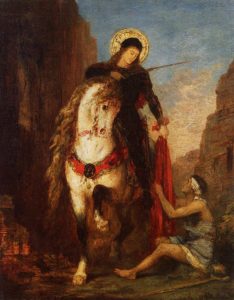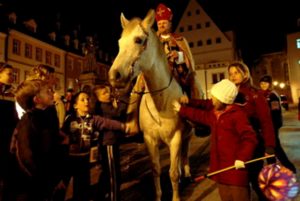 As I publish this blogpost, I am happy to say that Halloween has officially arrived! The air is permeated with magic and the veil between the worlds is so thin that I can see and feel spirits around every corner! This is truly the most amazing time of year. The topic of today’s post is Saint Martin’s Day, a holiday that we have not yet discussed on this blog yet one that has strong spiritual elements and is a celebration of the late harvest much like Halloween and the American Thanksgiving. Saint Martin’s Day, which falls of the 11th of November is also known as Old Halloween due to the fact that it had been celebrated on October 31st in the British Isles prior to 1752 when the Gregorian calendar was adopted thus shifting the date 11 days forward. This would account for why many of the traditions commonly associated with Halloween such as the wearing of costumes, bonfires and activities similar to trick-or-treat were carried over to St. Martin’s Day and still continue to be observed in various countries throughout Europe. I would like to explore some of the customs associated with this special day.
As I publish this blogpost, I am happy to say that Halloween has officially arrived! The air is permeated with magic and the veil between the worlds is so thin that I can see and feel spirits around every corner! This is truly the most amazing time of year. The topic of today’s post is Saint Martin’s Day, a holiday that we have not yet discussed on this blog yet one that has strong spiritual elements and is a celebration of the late harvest much like Halloween and the American Thanksgiving. Saint Martin’s Day, which falls of the 11th of November is also known as Old Halloween due to the fact that it had been celebrated on October 31st in the British Isles prior to 1752 when the Gregorian calendar was adopted thus shifting the date 11 days forward. This would account for why many of the traditions commonly associated with Halloween such as the wearing of costumes, bonfires and activities similar to trick-or-treat were carried over to St. Martin’s Day and still continue to be observed in various countries throughout Europe. I would like to explore some of the customs associated with this special day.
 November 11th is the Feast of Saint Martin of Tours who was a 4th century Roman soldier originally from what is today Hungary who converted to Christianity as an adult and was baptized by a monk and later consecrated as a bishop in the Roman province of Gaul, which is today France. St. Martin was known for his humility and acts of charity, but also for his strength and power. A popular legend claims that Martin was so humble that he did not want to be proclaimed a bishop, so he hid in a barn surrounded by geese who gave him away by making noise. He was thus found and declared bishop of Tours, France. Due to this legend, roast goose is a popular food served on Saint Martin’s Day in Scandinavian countries. During the Middle Ages, the cult of Saint Martin of Tours spread throughout Europe and due to his examples of kindness, humility and charity he became known as a powerful intercessor and benefactor to those in need.
November 11th is the Feast of Saint Martin of Tours who was a 4th century Roman soldier originally from what is today Hungary who converted to Christianity as an adult and was baptized by a monk and later consecrated as a bishop in the Roman province of Gaul, which is today France. St. Martin was known for his humility and acts of charity, but also for his strength and power. A popular legend claims that Martin was so humble that he did not want to be proclaimed a bishop, so he hid in a barn surrounded by geese who gave him away by making noise. He was thus found and declared bishop of Tours, France. Due to this legend, roast goose is a popular food served on Saint Martin’s Day in Scandinavian countries. During the Middle Ages, the cult of Saint Martin of Tours spread throughout Europe and due to his examples of kindness, humility and charity he became known as a powerful intercessor and benefactor to those in need.
 The modern day celebration of Saint Martin’s Day has much in common with Halloween and even the American observance of Thanksgiving. This is perhaps due to the fact that when the Julian calendar was in use, the feast fell on the 31st of October and then moved to the 11th of November with the adoption on the Gregorian calendar. For this reason the day is often known as Old Halloween or Old Hallowmas. Many of the traditions associated with Halloween such as bonfires, costume parties and parades and the carrying of lanterns, even sometimes jack-o-lanterns, have become commonplace on the feast of Saint Martin. It is also common for villages and towns throughout Europe to host St. Martin Day parades where a costumed person on horseback representing St. Martin is followed by groups of costumed children. Begging for candy door to door in a ritual similar to trick or treat is also common. St. Martin’s Day is also seen as a festival of the late harvest and a time to enjoy and give thanks for the abundance of produce received from the earth. In Spain, Saint Martin’s day is a traditional day for slaughtering farm animals and preparing meat for the winter ahead as can be seen in the popular refrain, A todo cerdo le toca su San Martín, “every pig has his Saint Martin’s Day.” In the United Kingdom there is a particular folk belief surrounding the weather on Saint Martin’s Day. It is believed that if it is cold of Saint Martin’s Day, then the winter will be mild but it is warm, then an icy cold winter will follow. There is often a snap of warmer weather around Saint Martin’s Day that is called Martin’s Summer, similar to the concept of an Indian summer in North America. In short, the Feast of Saint Martin is a day filled with magic, tradition and lore and one that celebrates a beautiful and powerful saint who is an example of kindness, charity and love.
The modern day celebration of Saint Martin’s Day has much in common with Halloween and even the American observance of Thanksgiving. This is perhaps due to the fact that when the Julian calendar was in use, the feast fell on the 31st of October and then moved to the 11th of November with the adoption on the Gregorian calendar. For this reason the day is often known as Old Halloween or Old Hallowmas. Many of the traditions associated with Halloween such as bonfires, costume parties and parades and the carrying of lanterns, even sometimes jack-o-lanterns, have become commonplace on the feast of Saint Martin. It is also common for villages and towns throughout Europe to host St. Martin Day parades where a costumed person on horseback representing St. Martin is followed by groups of costumed children. Begging for candy door to door in a ritual similar to trick or treat is also common. St. Martin’s Day is also seen as a festival of the late harvest and a time to enjoy and give thanks for the abundance of produce received from the earth. In Spain, Saint Martin’s day is a traditional day for slaughtering farm animals and preparing meat for the winter ahead as can be seen in the popular refrain, A todo cerdo le toca su San Martín, “every pig has his Saint Martin’s Day.” In the United Kingdom there is a particular folk belief surrounding the weather on Saint Martin’s Day. It is believed that if it is cold of Saint Martin’s Day, then the winter will be mild but it is warm, then an icy cold winter will follow. There is often a snap of warmer weather around Saint Martin’s Day that is called Martin’s Summer, similar to the concept of an Indian summer in North America. In short, the Feast of Saint Martin is a day filled with magic, tradition and lore and one that celebrates a beautiful and powerful saint who is an example of kindness, charity and love.
I hope you have enjoyed this post and I thank you for taking the time to visit my blog. As always, I wish you peace, happiness and abundant blessings!